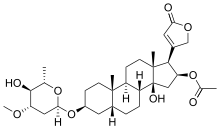
Back غليكوسيد Arabic Qlükozit Azerbaijani Гліказіды Byelorussian Гликозид Bulgarian Glikozidi BS Glicòsid Catalan Glykosidy Czech Glykosid Danish Glycoside German Glucósido Spanish


In chemistry, a glycoside ⫽ˈɡlaɪkəsaɪd⫽ is a molecule in which a sugar is bound to another functional group via a glycosidic bond. Glycosides play numerous important roles in living organisms. Many plants store chemicals in the form of inactive glycosides. These can be activated by enzyme hydrolysis,[1] which causes the sugar part to be broken off, making the chemical available for use. Many such plant glycosides are used as medications. Several species of Heliconius butterfly are capable of incorporating these plant compounds as a form of chemical defense against predators.[2] In animals and humans, poisons are often bound to sugar molecules as part of their elimination from the body.
In formal terms, a glycoside is any molecule in which a sugar group is bonded through its anomeric carbon to another group via a glycosidic bond. Glycosides can be linked by an O- (an O-glycoside), N- (a glycosylamine), S- (a thioglycoside), or C- (a C-glycoside) glycosidic bond. According to the IUPAC, the name "C-glycoside" is a misnomer; the preferred term is "C-glycosyl compound".[3] The given definition is the one used by IUPAC, which recommends the Haworth projection to correctly assign stereochemical configurations.[4]
Many authors require in addition that the sugar be bonded to a non-sugar for the molecule to qualify as a glycoside, thus excluding polysaccharides. The sugar group is then known as the glycone and the non-sugar group as the aglycone or genin part of the glycoside. The glycone can consist of a single sugar group (monosaccharide), two sugar groups (disaccharide), or several sugar groups (oligosaccharide).
The first glycoside ever identified was amygdalin, by the French chemists Pierre Robiquet and Antoine Boutron-Charlard, in 1830.[5]
- ^ Brito-Arias, Marco (2007). Synthesis and Characterization of Glycosides. Springer. ISBN 978-0-387-26251-2.
- ^ Nahrstedt, A.; Davis, R.H. (1983). "Occurrence, variation and biosynthesis of the cyanogenic glucosides linamarin and lotaustralin in species of the Heliconiini (Insecta: Lepidoptera)". Comparative Biochemistry and Physiology Part B: Comparative Biochemistry. 75 (1): 65–73. doi:10.1016/0305-0491(83)90041-x.
- ^ "Glycosides". IUPAC Gold Book - Glycosides. 2009. doi:10.1351/goldbook.G02661. ISBN 978-0-9678550-9-7.
- ^ Lindhorst, T.K. (2007). Essentials of Carbohydrate Chemistry and Biochemistry. Wiley-VCH. ISBN 978-3-527-31528-4.
- ^ Robiquet; Boutron-Charlard (1830). "Nouvelles expériences sur les amandes amères et sur l'huile volatile qu'elles fournissent" [New experiments on bitter almonds and the volatile oil that they provide]. Annales de Chimie et de Physique. 2nd series (in French). 44: 352–382.
© MMXXIII Rich X Search. We shall prevail. All rights reserved. Rich X Search